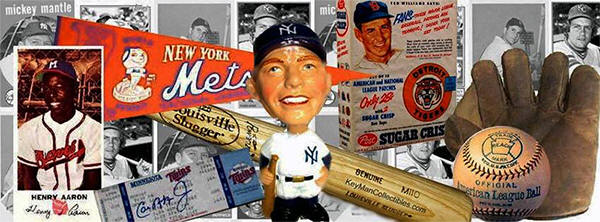| |
 |
|
WWI 'K-C' Knights Of
Columbus War Chest
Baseball Bat |
|
|
Item Details |
-
CIRCA
- 1918
-
MANUFACTURER
-
Spalding
-
SIZE
- 35"
-
PRICE GUIDE
- $200.00-$300.00
Very Good -
Excellent
condition
Because of scarcity
and lack of sales
data, the value is
estimated based on
selling prices of
Y.M.C.A. Bat & Ball
fund baseball bats
without a player
endorsement .
Information
Provided by:
Keymancollectibles.com
|
|
|
|
| |
|
|
| |
Days after the U.S. entered the first
World War in April of 1917, President
Woodrow Wilson created a new Federal
Agency, the Commission on Training Camp
Activities. The program was designed to
clean up the immoral influences
associated with encampments and their
surrounding communities. It was a great
concern to the American Family, for the
moral destruction of their sons, and
husbands going off to war. The program
would help surround our troops with a
healthy, cheerful environment, and to
ensure the purity of the camp
environment. Training camps would then
mold not only soldiers, but model
citizens who after the war would return
to their communities spreading urban
middle-class values throughout the
country.
Almost immediately organizations such as the Knights of Columbus the YMCA,
the YWCA, the Jewish Welfare Board, the
Salvation Army, and the American
Library Association worked to supply
recreational services and raise money
for equipment. The WWI "bat and ball
fund" was started. Shortly after the
CTCA - Commission on Training Camp
Activities was in place, Washington
Senators owner Clark Griffith launched
a plan to support our troops by raising
money to purchase athletic equipment.
mostly baseball gear, to outfit every
U.S. military training camp.
The Knights of Columbus was active in raising money for the Bat & Ball fund,
which was contributed to the Y.M.C.A.
through the Red Cross. In 1918 Money
was allotted to the Knights of Columbus
to send secretaries to France that
would take supplies referred to as "War
Chests" to the front, and set up
"recreation Huts." This caused
controversy in the press because the K
of C was a Christian group and money
was being donated by Americans not of
the Roman Catholic church. They accused
the Knights of stealing money from the
YMCA and Red Cross in order to fund its
activities on behalf of “the papal
government." All in all, it was for a
good cause and was sanctioned by both President
Woodrow Wilson and the War
Department Commission on Training Camp
Activities. All soldiers regardless of
faith were welcomed to the K of C
recreation huts.
During their first month the Knights of Columbus passed out 37,719 cartons
of chocolate; 25,250 cartons of chewing
gum; 14,772 baseballs, 2,286 sets of
boxing gloves, and 1,687 football; 10
million sheets of writing paper and 8
million envelopes. The baseball bats
branded with the Knights of Columbus
"K-C" shield were shipped to France by
a number of Knights of Columbus
secretaries.
In August of 1918, serving in France as a Knights of Columbus Field
Secretary, and Athletic Director, Cubs
second baseman Johnny Evers of the
famed Tinker to Evers to Chance double
play combo, was sent to France by the
Knights of Columbus, along with 200
other secretaries. Evers and the other
secretaries were sent "over there" with
a trunk ('War Chest') which was packed with a
complete set of athletic paraphernalia,
footballs, boxing gloves and tennis
sets. The trunk also included four
baseball bats, two indoor baseball
bats, two dozen
K-C Stamped baseballs, two catchers
mitts, seven fielders gloves, and one
chest protector. Evers as well as the
other secretaries, had their set
replaces as often as necessary.
The teams that were put together by the Y.M.C.A and the Knights of
Columbus, put Evers in charge. The team
started a tour in September with the
first game played in Paris against a
team recruited from the Paris League
clubs, which consisted of players who played
in the minor leagues before going
abroad. In November and December the
tour moved to Southern France where the
weather was more favorable. Although
the war ended in November, the boys
were still "over there" and needed help
to see them through until their return. The team
played against Hospital staff for the
benefit of wounded warriors.
Evers pitching staff consisted of famous
major league players, that included:
Grover Cleveland Alexander; ex Dodger
pitcher Sherrod Smith, Leon Cadore of
the Dodgers, who was serving as a
Lieutenant in the Army, Otis Lambeth a
former Indian, and Charley Noyes who
was one of Connie Mack's Spring Crop of
youngsters on the Athletics the year
before. Catcher Hank Gowdy formerly of
the Boston Braves, had the honor of
being the first ball player to enlist
in the Army. The infield included the
Cardinals Dots Miller. Evers was slated
to cover second base. Athletics Cy
Bates at third, and former Dodger Chuck
Ward at Short. The outfield comprised
of Mike Menosky and Same Rice of the Senators,
one time Indian Miller, and Lee Magee.
Cardinals Manager Jack Henddricks
joined
the team in October.
|
|
| |
|
1917 WWI Bat & Ball
Fund Spalding 'K-C' Knights Of
Columbus Baseball Bat |
|
 |
|
 |
|
|
KEYMAN COLLECTIBLES
RELATED RESOURCES |
|
|
|


